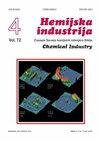Characterization of surface roughness of new nanophotonic soft contact lenses using lacunarity and AFM method
IF 0.8
4区 工程技术
Q4 ENGINEERING, CHEMICAL
引用次数: 2
Abstract
The aim of this work was to develop new soft contact lens (SCL) materials which would, after recommended and existing machining processes, improve surface roughness. Nanomaterials were incorporated into commercial material for SCL (SL38) based on PHEMA, which were derived by the technology in the production lab of the company Soleko (Milan, Italy). Nanophotonic SCLs (SL38-A, SL38-B, SL38-C) were produced in the company Optix (Belgrade, Serbia) from the obtained materials. For the surface characterization of SCLs, AFM analysis and lacunarity method were performed. The results showed that SL38-B average roughness value is lower than SL38-A and SL38. The topography parameters of SL38-C were between the parameters of SL38-A and SL38-B. Lacunarity analysis of AFM images confirmed that SCLs surface state should belong to either group of adequate (slanted p -diagram) or inadequate (contorted p -diagram) roughness concerning tear film stability. Nanophotonic SCL SL38-C evince more acceptable performance consider SCL surface functional behavior compare other SCLs. The positive result of incorporating nanomaterials into basic material for SCL is better quality of the nanophotonic SCLs surfaces. On the bases of these experiments, the assumption that incorporation of fullerene derivate can play a role in the prevention of a significant increase in roughness is confirmed.利用腔隙和原子力显微镜表征新型纳米光子软性隐形眼镜表面粗糙度
这项工作的目的是开发新的软性隐形眼镜(SCL)材料,经过推荐和现有的加工工艺,可以改善表面粗糙度。纳米材料被纳入基于PHEMA的SCL (SL38)的商业材料中,这是由Soleko公司(米兰,意大利)的生产实验室的技术衍生而来的。由Optix公司(Belgrade, Serbia)利用获得的材料生产出纳米光子SCLs (SL38-A, SL38-B, SL38-C)。利用AFM分析和空隙度法对scl进行了表面表征。结果表明,SL38- b的平均粗糙度值低于SL38- a和SL38。SL38-C的地形参数介于SL38-A和SL38-B之间。AFM图像的间隙分析证实,与泪膜稳定性相关的scl表面状态应属于适当(倾斜p图)或不适当(扭曲p图)粗糙度组。考虑到纳米光子SCL的表面功能行为,与其他SCL相比,SL38-C具有更可接受的性能。将纳米材料掺入SCL基础材料的积极结果是纳米光子SCL表面质量更好。在这些实验的基础上,假设富勒烯衍生物的掺入可以起到防止粗糙度显著增加的作用。
本文章由计算机程序翻译,如有差异,请以英文原文为准。
求助全文
约1分钟内获得全文
求助全文
来源期刊

Hemijska Industrija
工程技术-工程:化工
CiteScore
1.60
自引率
11.10%
发文量
12
审稿时长
6-12 weeks
期刊介绍:
The Journal Hemijska industrija (abbreviation Hem. Ind.) is publishing papers in the field of Chemical Engineering (Transport phenomena; Process Modeling, Simulation and Optimization; Thermodynamics; Separation Processes; Reactor Engineering; Electrochemical Engineering; Petrochemical Engineering), Biochemical Engineering (Bioreactors; Protein Engineering; Kinetics of Bioprocesses), Engineering of Materials (Polymers; Metal materials; Non-metal materials; Biomaterials), Environmental Engineeringand Applied Chemistry. The journal is published bimonthly by the Association of Chemical Engineers of Serbia (a member of EFCE - European Federation of Chemical Engineering). In addition to professional articles of importance to industry, scientific research papers are published, not only from our country but from all over the world. It also contains topics such as business news, science and technology news, information on new apparatus and equipment, and articles on environmental protection.
 求助内容:
求助内容: 应助结果提醒方式:
应助结果提醒方式:


